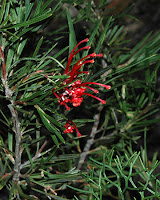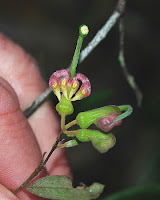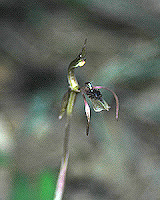Eucalyptus aquatica
 Today I went with the Australian Plants Society to the Bundanoon and Penrose areas, on an expedition led by John Dorman, a very experienced Native Plant observer.
Today I went with the Australian Plants Society to the Bundanoon and Penrose areas, on an expedition led by John Dorman, a very experienced Native Plant observer.Firstly we went to a small swamp, deep in the middle of the Penrose State Forest. A forestry worker was busy cutting trees with a truly remarkable machine, which is a combination machine, which has a gripping device, a blade, a system for running the trunk along through the teeth, to cut off side branches. The whole machine also acts as a long-armed lifting machine, like a large back-hoe, to dump the cut truck once it has been trimmed.
 The first thing we saw was a rare gum, Eucalyptus aquatica, (see photo of the fruit capsules, at left) growing in damp soil, amongst sedges, and other swamp plants.
The first thing we saw was a rare gum, Eucalyptus aquatica, (see photo of the fruit capsules, at left) growing in damp soil, amongst sedges, and other swamp plants.We also found many other interesting plants, including 3 species of Persoonia - P. oxycoccoides (at 80 cm high, this was a tall species of this normally prostrate plant), P. mollis and P. laurina, with its typical rough sand-papery textured leaves.
Grevillea molyneuxii
 We then returned to a private property closer to Bundanoon, where we could walk into the Morton National Park, in a point overlooking the Shoalhaven Valley. This was a great location.
We then returned to a private property closer to Bundanoon, where we could walk into the Morton National Park, in a point overlooking the Shoalhaven Valley. This was a great location.We walked along a fire trail until we got out onto a rocky shelf, in a quite exposed position, where we were able to see the rare Grevillea molyneuxii in flower. Just small shrubs, with narrow leaves, and these stunning bright red flowers.
This plant was first discovered in the 1930s, but was not formally described until re-discovered by Bill Molyneux in 1976. It has a very restricted distribution, along the western edge of the Shoalhaven.
Grevillea arenaria
 This Grevillea is quite common in this area, but it has an interesting flower shape, with the "tepals" having distinctive pointed tips, below the little "sacs" where the pollen is held. These features are quite clearly visible in this photograph. (Click on the image, to enlarge it). Most Grevillea flowers have rounded ends to the 4 tepals, and they are not normally curled around as in this species.
This Grevillea is quite common in this area, but it has an interesting flower shape, with the "tepals" having distinctive pointed tips, below the little "sacs" where the pollen is held. These features are quite clearly visible in this photograph. (Click on the image, to enlarge it). Most Grevillea flowers have rounded ends to the 4 tepals, and they are not normally curled around as in this species.The long tall structure in the top of this photo is the "pollen presenter" which holds the female structure, (the stigma) at the end. It starts out acting as a false male organ, carrying pollen which was stuck to it when it was curled around into the centre of the flower (as in the flower on the right of the screen). When that structure develops, it straightens out, taking with it the fresh pollen. Then, when the pollen has dried, or been taken by a bird or insect, this organ becomes green, and sticky. It is then receptive to being brushed by pollen from another flower. At that point it is fulfilling its true role as the female organ, the stigma.
Chiloglottis seminuda
 This is a tiny Ground Orchid, which was found growing in the tall forest closer back up to the top of the hillside. It was growing on a different soil and rock base, and amongst tall Eucalypts. Once we found the first of these plants (two leaves growing flat on the ground) we realised that there were literally hundreds of leaves of these plants under-foot.
This is a tiny Ground Orchid, which was found growing in the tall forest closer back up to the top of the hillside. It was growing on a different soil and rock base, and amongst tall Eucalypts. Once we found the first of these plants (two leaves growing flat on the ground) we realised that there were literally hundreds of leaves of these plants under-foot.This tiny flower has a structure resembling an insect on its lip (labellum). The column (with pollen visible) is held above the tongue. This plant is pollinated by male wasps, which attempt to mate with this flower, because it emits a scent resembling the pheromone of particular female wasps, this confusing the male wasps. This process is known as "pseudo-copulation".
It was a great outing by the Southern Highlands branch of the Australian Plants Society.

1 comment:
hi Denis,
I enjoyed the fruits of your bushwalk very much.
I have included a Chiloglottis species in my most recent blog entry which I have not yet published.
The orchid that I observed is (I think) Chiloglottis reflexa (Autumn Bird-orchid). Can you tell me please, what distinguishes the orchid that you found, Chiloglottis seminuda (Forest Bird-orchid) from the former?
Comparing my picture with yours, the flowers look the same, also with two ground-hugging leaves with plants enmass.
Regards
Gaye
Post a Comment